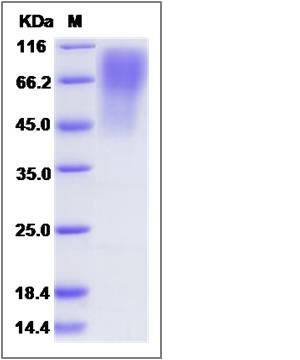Rat CD68 / Macrosialin Protein (His Tag)
CD68
- 100ug (NPP3009) Please inquiry
| Catalog Number | P80307-R08H |
|---|---|
| Organism Species | Rat |
| Host | Human Cells |
| Synonyms | CD68 |
| Molecular Weight | The recombinant rat CD68 comprises 287 amino acids and predicts a molecular mass of 30.9 kDa. The apparent molecular mass of the recombinant protein is approximately 66-90 kDa in SDS-PAGE under reducing conditions due to glycosylation. |
| predicted N | Asp 21 |
| SDS-PAGE |  |
| Purity | > 95 % as determined by SDS-PAGE |
| Protein Construction | A DNA sequence encoding the rat CD68 (Q4FZY1) (Met1-Ser295) was expressed, fused with a polyhistidine tag at the C-terminus. |
| Bio-activity | |
| Research Area | Immunology |Inflammation / Inflammatory Mediator |Cells Involved in Inflammation |Monocyte/Macrophage |
| Formulation | Lyophilized from sterile PBS, pH 7.4 1. Normally 5 % - 8 % trehalose, mannitol and 0.01% Tween80 are added as protectants before lyophilization. Specific concentrations are included in the hardcopy of COA. |
| Background | Macrosialin, also known as CD68 and Gp110, is a single-pass type I membrane protein which belongs to the LAMP family. CD68 is highly expressed by blood monocytes and tissue macrophages. It is also expressed in lymphocytes, fibroblasts and endothelial cells. CD68 is expressed in many tumor cell lines which could allow them to attach to selectins on vascular endothelium, facilitating their dissemination to secondary sites. CD68 plays a role in phagocytic activities of tissue macrophages, both in intracellular lysosomal metabolism and extracellular cell-cell and cell-pathogen interactions. It is a commonly used marker for macrophages. However, a number of studies have shown that CD68 antibodies react with other hematopoietic and non-hematopoietic cell types, suggesting that CD68 may not be a macrophage-specific antigen. CD68 binds to tissue- and organ-specific lectins or selectins, allowing homing of macrophage subsets to particular sites. Rapid recirculation of CD68 from endosomes and lysosomes to the plasma membrane may allow macrophages to crawl over selectin-bearing substrates or other cells. |
| Reference |
